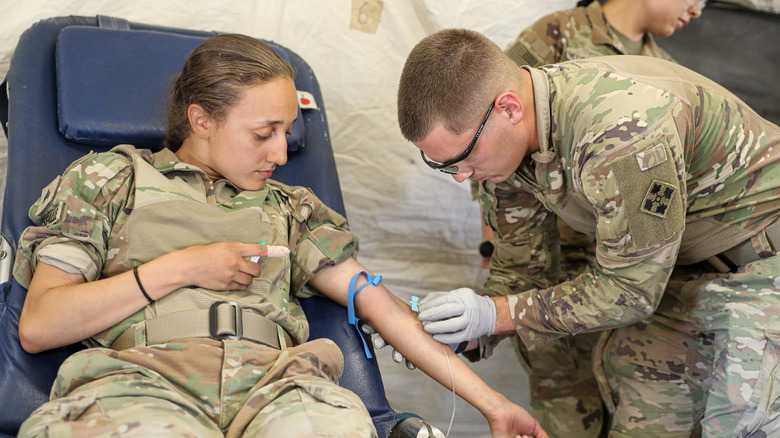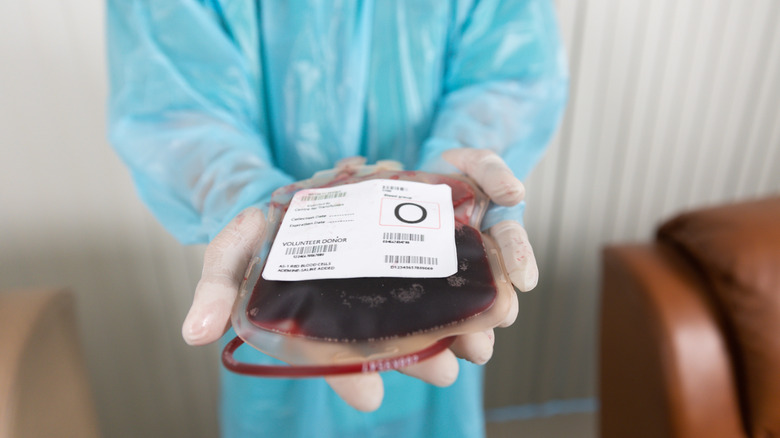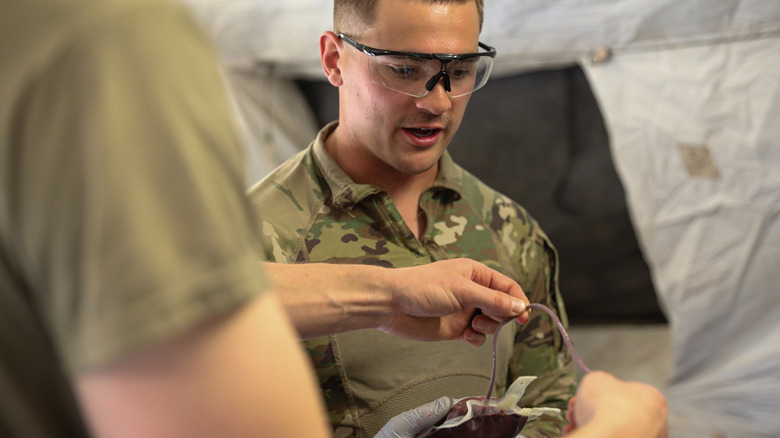The US Army Is Using Soldiers As 'Walking Blood Banks' Like They Did In WWI
Soldiers of the U.S. Army can find themselves stationed in the most remote, challenging places, even Arctic conditions requiring special training. Survival is always at the forefront of their activities, and it's for this reason that they may at times carry such heavy loads. There's one precious resource, however, that soldiers in such remote locations may be in particular need of, and which isn't so easily transported in a backpack: Blood.
In the line of duty, members of the armed forces may be tragically injured, and vital medical aid beyond their essential supplies may be necessary but out of reach. One resourceful way to get around this issue is by having the soldiers themselves serve as walking blood banks, a way of accessing life-saving blood that would otherwise be very difficult to store or transport safely. Medical personnel will typically want to remain within the so-called Golden Hour, a period that the University of Birmingham's Dr Jon Hazeldine describes, per the Midlands Air Ambulance Charity, as the one "within 60-minutes of their injury, a crucial time in which prompt medical treatment is key to survival." Donors in the same unit, as such, are perhaps the most convenient and fastest way of getting that blood to stricken soldiers.
The army continues to develop the technique and explore its implementation, with a September 2025 exercise at the Joint Multinational Readiness Center practicing treating those 'wounded' by simulated artillery strikes using blood donations from their comrades. Unfortunately, it's not as easy as simply finding a willing donor, because for a transfusion, the blood needs to be compatible. The U.S. Army has developed a fascinating way of helping ensure that the process is safe and effective, because whole blood donations, while they've been used for a long time in warfare, have their risks.
The wonders of type O blood and antibodies
Type O is an incredibly valuable blood type to have. This is because of its universality. O positive blood is the most commonly found type, estimated to be shared by around 38% of people. It's extremely important for when donations and transfusions are needed, because it is compatible with the red blood cells of A positive, B positive, AB positive, and O positive people. O negative is even more unique, being able to be used in donations for anybody. What this means is that servicepeople in the army who have Type O can have the very special role of providing that blood, which has led to the U.S. Army reviving the concept of 'walking blood banks.' The critical thing, of course, is to be able to do so efficiently and safely for both parties. To that end, an initiative of the Armed Services Blood Program began in 2019 to determine not only which members of the XVIII Airborne Corps had Type O blood, but also which of them paired it with a low antibody count, also known as a low titer.
Lieutenant Colonel Melanie Sloan of the Fort Bragg Blood Donor Center reported, per the U.S. Army, that such antibodies "are naturally occurring and can attach themselves to transfused blood cells. The titer testing helps identify individuals with lower levels of these antibodies." Though a positive force within the human body, these antibodies can represent an enormous danger inadvertently. As is their purpose, they can attack and attempt to overwhelm that which doesn't 'belong,' which is a huge risk factor to consider with transplants and transfusions. Even with the advantage of O Positive blood, this was a risk factor to limit.
Discovering and refining the walking blood bank
Deputy Corps Surgeon Lieutenant Colonel George Barbee noted to the U.S. Army in 2019 that, as well as later in World War I, "we were still doing whole blood transfusions in World War II up through the conflicts in Korea and Vietnam." After the latter conflict, blood component therapy, whereby the blood is reduced down to platelets, red blood cells themselves, and plasma, and stored separately, was commonly used instead. This system had the advantage of offering more versatility and treating more specific needs. For instance, a patient requiring blood cells and another in need of platelets could both receive crucial treatment from what was originally the same blood, and the risks of the introduction of new elements into the body were reduced.
Nonetheless, potentially fatal injuries causing heavy blood loss require very quick action. More recently, as Lieutenant Barbee put it, "we have done a lot of studies to see what the best method was for saving lives through transfusion ... they pointed back to whole blood." Sophisticated and fast-acting tests for blood types and antibody levels have made it safer and more practical to explore the method again, cutting the risk of disease or infection with the screening of soldiers designated as walking blood banks.
Stored and safely refrigerated blood can't be dispensed with entirely. These Type O soldiers aren't a primary supply to rely on, but a valuable backup to take the pressure off of vulnerable and fragile stored blood. Quick access to on-site medical supplies and attention can help prevent air crews from putting themselves in danger, while also helping get the wounded treated as quickly as possible. Important innovations like the MASH unit have helped with these efforts, too.


